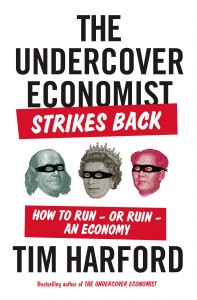Are Recessions Like Prison Camps or Baby-sitting Co-ops?
 Tim Harford, who writes the Financial Times‘s “Undercover Economist” column, has appeared on our blog many times. This guest post is part of a series adapted from his new book The Undercover Economist Strikes Back: How to Run or Ruin an Economy.
Tim Harford, who writes the Financial Times‘s “Undercover Economist” column, has appeared on our blog many times. This guest post is part of a series adapted from his new book The Undercover Economist Strikes Back: How to Run or Ruin an Economy.
Robert A. Radford studied economics at Cambridge University, and worked at the International Monetary Fund. In between, he spent half the war in a German prison camp, and on his release wrote an article, “The Economic Organization of a P.O.W. Camp.” It gives a surprising insight into economic recessions.
The building blocks of the P.O.W. camp economy were parcels of food and cigarettes that the prisoners received from the Red Cross. These parcels were standardized—everybody got the same, beyond the occasional package from home. Occasionally, the Red Cross received bumper supplies, or ran short; in those circumstances everybody enjoyed a surplus or a shortage. Naturally enough, while prisoners had equal rations, they did not have identical preferences. The Sikhs didn’t have much use for their rations of beef or razor blades, for example; the French were desperate for more coffee; the English wanted more tea.
There was not much production in the prison camp economy, but there was some: some men would, for instance, offer to polish boots or press uniforms. One entrepreneurial fellow set up a cart selling tea, coffee, and cocoa. At one stage, he enjoyed the services of a chartered accountant, and paid other prisoners to gather fuel. And there was government provision too, of a sort: the Senior British Officer set up a camp shop and restaurant, including live entertainment. Chiefly, though, the P.O.W. camp economy was built on trading, and plenty of trading took place.
Market institutions emerged spontaneously. There was a currency: the cigarette, which was portable and reasonably homogeneous. Non-smokers, not being tempted to burn their “money,” were naturally at a distinct advantage. There was a futures market: with bread rations handed out on Monday, on Sunday evening “bread now” traded at a premium to “bread Monday.” There were even imports and exports—coffee would go “over the wire” to be sold in black-market cafés in Munich because at times the Red Cross was able to supply the prisoners with things that German civilians themselves couldn’t get. And of course, when there is an opportunity to supply a scarce resource, the profit motive will usually find a way. Middlemen prospered, especially if they had the ability to speak multiple languages or had friendly relations with German guards who let them visit different parts of the camp.
Once Radford arrived at a permanent camp, he found that prices tended to be stable and well known, precisely because there were middlemen around, seeking out bargains and arbitrage opportunities. But while prices didn’t bounce around like the offers to naïve tourists at a bazaar, they did move in response to broader developments—for example, an influx of new, hungry prisoners of war would generally drive up the price of food; when the weather was hot, the price of cocoa fell and the price of soap rose; dried fruit prices rose sharply and stayed high after someone discovered that, in Radford’s words, “raisins and sugar could be turned into an alcoholic liquor of remarkable potency.”
These are all examples of what economists call an exogenous shock—meaning it isn’t a part of the economic system that we might model with our usual equations of supply and demand. Exogenous shocks (good and bad) to the economy of the United States itself have included cheap goods from China, the invention of the mobile phone, oil price spikes, fracking, and of course the collapse of the financial system in 2008.
Toward the end of the war, the camp economy suffered its biggest exogenous shock of all: the supply of Red Cross parcels gradually dried up. This caused a recession—volumes of trade grew smaller and smaller.
What is interesting about this recession is the contrast between another – now notorious – recession in a tiny economy. That was a babysitting co-op on Capitol Hill, made famous in accounts by Paul Krugman. In the babysitting co-op, the recession was caused because the economy itself misfired and got stuck; it needed a policy response to unstick it. This is typical of the “Keynesian” view of recessions, which is why Krugman, a Keynesian, finds it a helpful example.
The prison camp was different. The economy inside the camp worked perfectly. In difficult circumstances, the well-oiled economic machine worked just as it should. Unfortunately that didn’t stop the prisoners from approaching starvation, because the external shocks to the prison camp economy were so severe.
I realize that it sounds odd to contrast a prison camp with a babysitting co-op, but I think it can shed a lot of light on contemporary arguments among economists—for instance, over the question of stimulus versus austerity. What they’re really arguing over is this: is the economy currently operating more like a babysitting co-op, or more like a prison camp?
Excerpted from The Undercover Economist Strikes Back: How to Run or Ruin an Economy by Tim Harford, published by Riverhead Books.

Comments